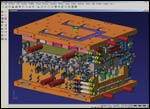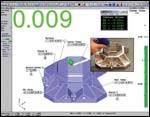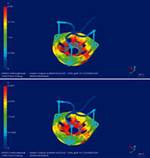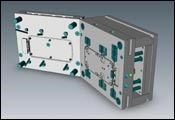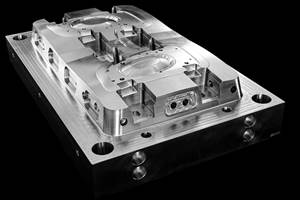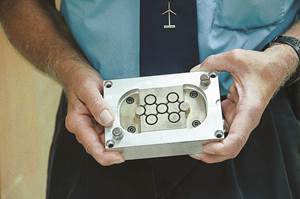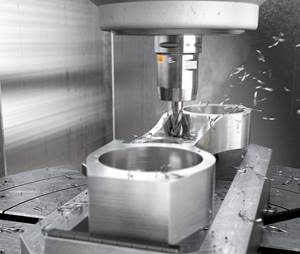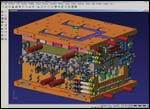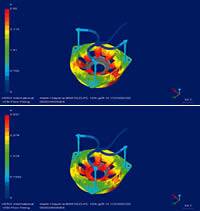New Design Strategy for Generating Hybrid Aluminum Tooling
Design, machining and analysis software aids in aluminum mold manufacture.
J&M Mold (Fairport Harbor, OH) is a precision tool and die maker for the plastic, aluminum and zinc injection industries. Owner David Martin is a mechanical engineer who says he has been working in the die casting industry since he was 13 years old. He has been using the full suite of VISI Series software from Vero International (Wixom, MI) since he opened his operation seven years ago.
He says that he addresses industry challenges by staying in tune with the latest technologies and new strategies for faster, more efficient mold assembly. “For instance, we use VISI Flow software to design accurate molds faster, and VISI Machining, for cutting steel, and high-feed milling. It’s very important that we get the part right the first time. This keeps our customers happy and we enjoy repeat business because of it,” says Martin.
As a student of lean thinking/lean manufacturing, Martin integrates the theories into his use of VISI products. He adds, “It seems that VISI software was designed around lean manufacturing with the constant flow of menu picks: all operations in one software package. VISI is a CAD system that was designed by people with toolmakers in mind.”
Designing Aluminum Molds
According to Martin, designing aluminum molds versus steel is becoming very popular even though he’s been working with aluminum since he opened up shop. “We use VISI to develop aluminum prototypes and short-run production tools. We are able to generate increasingly more parts from them,” notes Martin. As a result, aluminum is beginning to replace P20 steel, which has been traditionally used to produce molds that are 20-32 Rockwell. Aluminum molds will last for a long time as long as abrasive or corrosive plastics are not injected into them.
“Why build a P20 tool when you can build an aluminum tool that will last through thousands and thousands of shots or short-run production?” asks Martin. He cautions, however, that part materials and the molding process must be appropriate for aluminum molds.
“You cannot inject any part into an aluminum mold because of details such as thin-walled shut off designs. Such parts do not work as well in aluminum because the aluminum isn’t as structurally strong as steel.”
The Hybrid Solution
However, Martin has found a strategy around that caveat. “We sub-insert steel shut-offs or slides inside the aluminum mold design. We call this hybrid aluminum tooling and VISI is strategic for designing such tools. Critical or small parts of the mold design can be made of steel while the rest of the design is aluminum,” Martin says.
Aluminum is less expensive to machine and designing tools in aluminum is less costly for J&M Mold customers. Using VISI, Martin machined a steel plate over two days’ time. Whereas, the same plate designed and machined in aluminum took him just six hours. He says many customers are pleasantly surprised when he tells them he can help them save money by using aluminum versus steel for their mold designs. In addition, delivery of aluminum tools is at least 50 percent faster depending on the part design compared to steel molds.
“We can generate at least one aluminum tool per week. There is no room for error so we use VISI analysis upfront to assure that the design is accurate the first time,” Martin notes.
Using the VISI Series
Prior to implementing VISI Series, Martin downloaded several demonstration versions of popular general purpose CAD packages. “None of them compared to VISI’s user interface. Unlike the others, VISI is not parametrically driven so you don’t have to hunt and peck on tree-driven icons. Instead, VISI offers specific tools for specific tasks. For me, that gives me more control over exactly what I am doing.
“Most of my customers tell me they have a lot of trouble with tasks such as blending and meshing components. Using VISI, however, there’s no problem or angst over those efforts,” adds Martin.
He likes the VISI machining package, too, particularly the rest milling and pencil milling. Martin explains that he wouldn’t rough out a complex block without those tools. “The important aspects to consider for machining include ease of use, time to program, run time on the CNC, quality of finish and price. VISI beats the competition on all those issues,” says Al Foote, principal at Compass Technologies, an Ohio-based VISI Series distributor.
Martin says that using VISI for mold analysis is indispensable. “Customers understand the analyses add value to each and every project. They have come to realize and accept the fact that the cost incurred as a result of running the analysis actually helps them save time and money that can be incurred when molds that aren’t analyzed must be retooled. VISI Flow is as useful to me as the machine used to cut the tool. “
Project
Recently, a medical device customer approached J&M Mold. A mold that was designed and built in China was producing flawed parts in the field. Over a two-day period, Martin used VISI Flow to rework the mold gating system.
“Working with the customer and VISI Flow, we found the best gating situation for the part. I moved the gating to where I thought it would be best and used VISI Flow to confirm it. In addition, using VISI Mold we increased the mechanical integrity of the part design and strengthened the areas that needed to be stronger compared to the original Chinese designed mold. We designed and built the tool, shipped it, and as a result the mold generated high quality parts,” says Martin.
Learning Curve
Martin taught himself how to use VISI software. He began using VISI 3D machining to produce prototype parts out of plastic. Within one week, he was generating parts. After three months, he was completely competent—designing and building complete tools. Today, he and his staff can build two complex tools per month.
Related Content
Cast Plate Aluminum Alloy is Suitable for Production Mold and Dies
Alimex Precision in Aluminum introduces its 7000 series ACP7 mold material, featuring high mechanical properties, material stability and good machinability.
Read MoreHow to Select the Right Tool Steel for Mold Cavities
With cavity steel or alloy selection, there are many variables that can dictate the best option for moldmaking.
Read MoreRoughing, Finishing Aluminum-Specific End Mill Line Expansion
Extended range of Sandvik Coromant’s CoroMill Dura versatile solid end mills engages stable cutting, small burr, good surfaces and minimal vibration.
Read MoreTechnology Review and Sourcing Guide 2024: Mold Materials
Building a high-quality mold requires the proper selection of appropriate mold materials. Tool steel, aluminum, copper and alloys are a just a few examples you can fin in this exclusive, online-only content that includes a supplier list for mold materials.
Read MoreRead Next
Streamlining Processes with The Right CAD/CAM Package
VISI-Series provides the toolmaker a high level of productivity through its specialized applications, and offers dedicated solutions while eliminating the links between varying software suppliers and the solid-to-surface geometry conversions required by traditional systems.
Read MoreModern Software Solutions in Measurement Metrology Improve Mold Build and Verification
Inspection and verification that the mold and the products it yields comply with the master CAD design are open to the benefits from modern development in CAD/CAM technology.
Read MoreNew Technology Helps Users Accurately Design Molds
VISI-Flow software helps mold shop determine optimum mold specifications.
Read More
